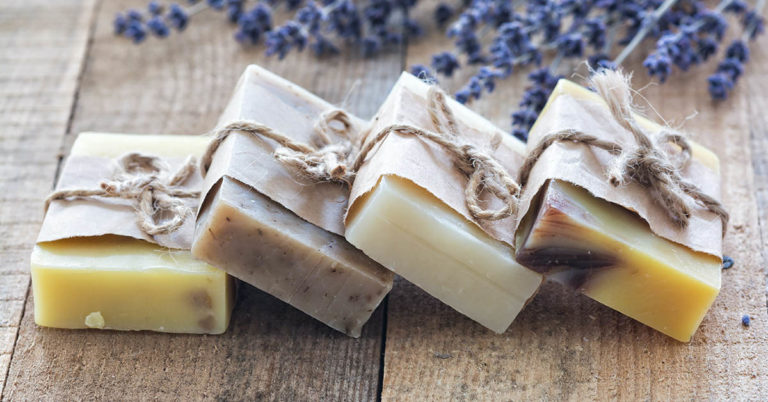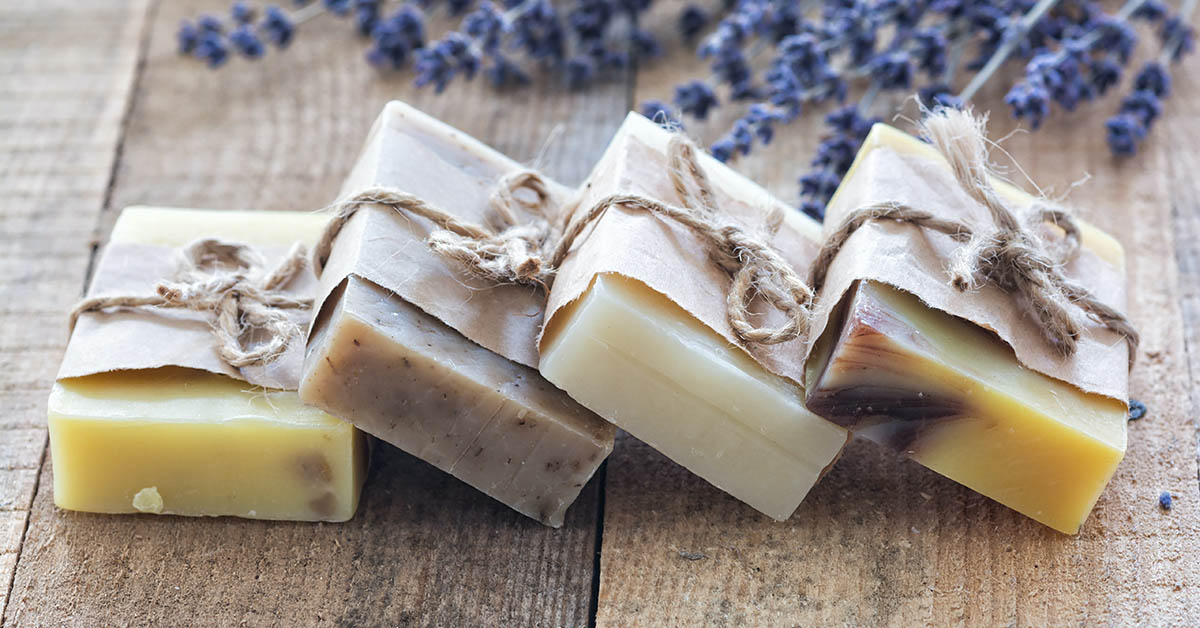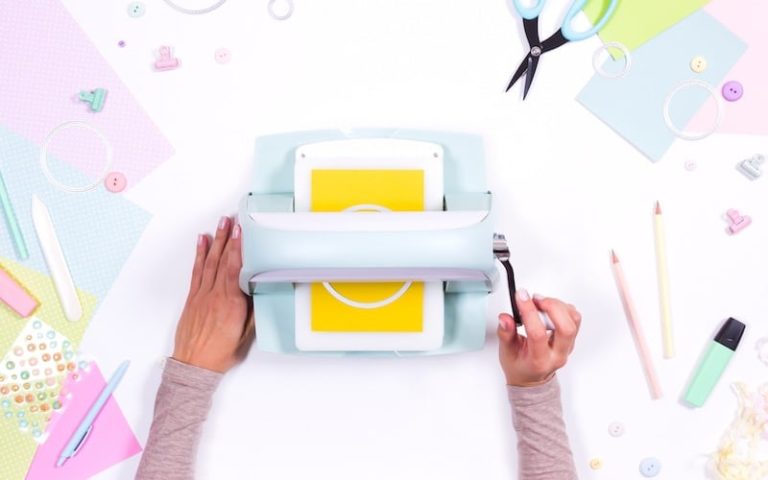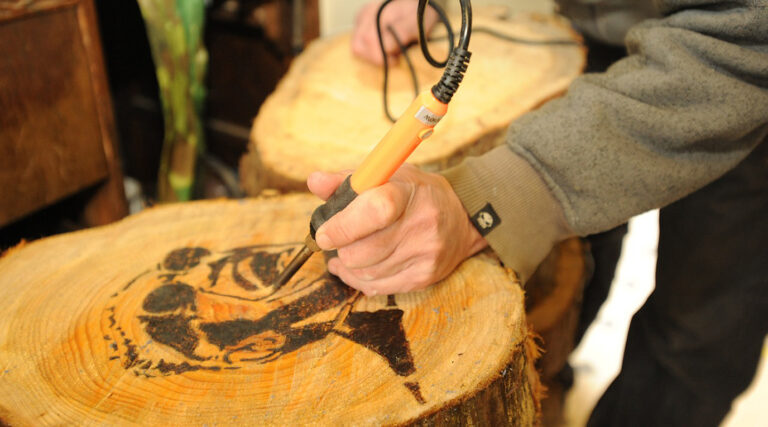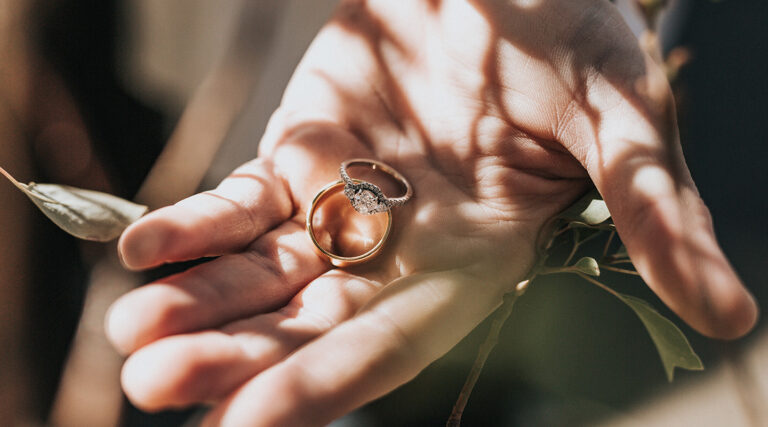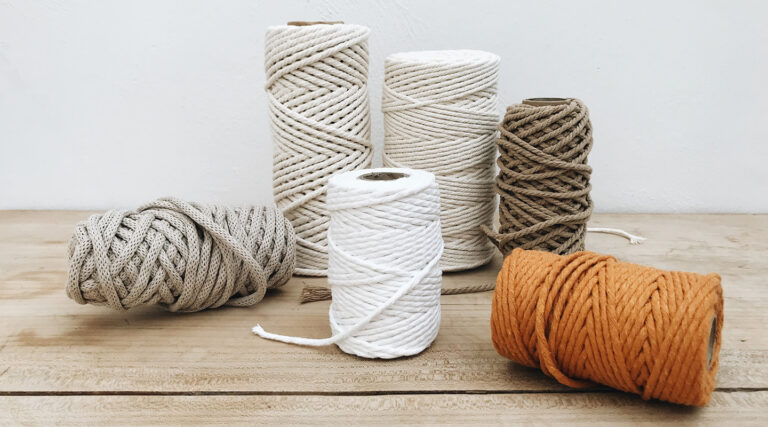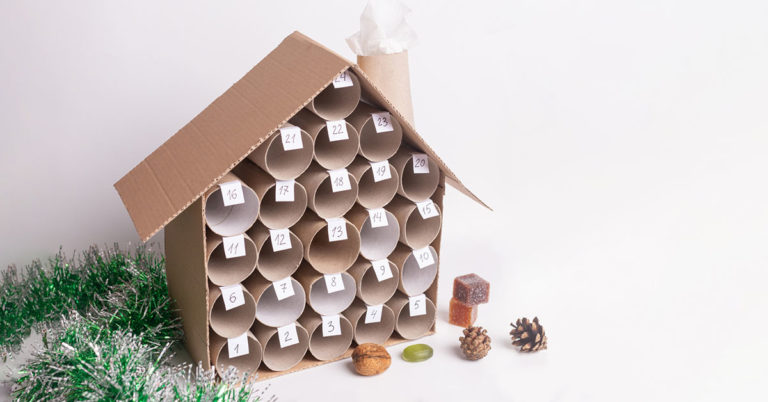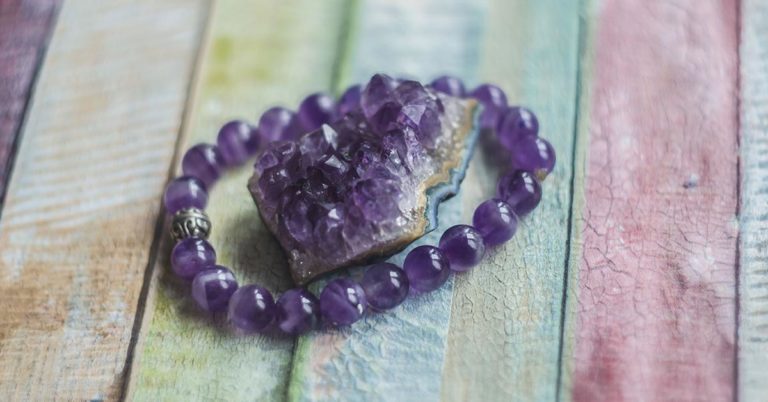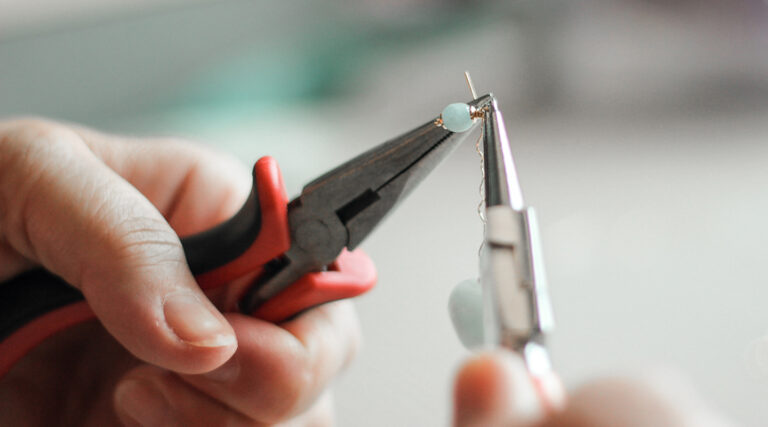In recent years, we’ve seen a resurgence in cottage crafts, as more and more people want to live more sustainable lifestyles.
As part of this, soap making has become very popular, and lots of DIY soap tutorials have popped up online.
The best DIY soap tutorials
Making handmade soap is easier than you may think. You just need a good tutorial to show you the way, especially if you’re new to the craft.
These tutorials will show you how to make different kinds of soaps, with a range of stunning effects. Many also use natural ingredients, and some break down the process in detail for complete beginners.
1. Cold process soap making tutorial
This detailed tutorial walks you through every step of the cold soap-making process, starting with making a lye (sodium hydroxide) solution. Aimed at beginners, the video also explains the how’s and why’s of the various steps.
This tutorial uses olive oil and coconut oil to make the soap using a cold process, which many soap-makers prefer as it will give you a longer lasting bar of soap. Once you learn the process from this video tutorial, you’ll be able to apply your skills and knowledge to make a range of cold process soaps!
If you want to learn how to make your own cold process soap, watch the video tutorial here.
2. Complete beginners guide to soap making
This cold process soap making video tutorial is aimed at absolute beginners, even if you have no soap making experience. It gives a range of safety tips, including safety equipment, as well as all the tools and supplies you’ll need.
The video also gives you an overview of the science, so you’ll get an idea of how the process works before you jump in. Essentially, making cold process soap is a chemical reaction between lye and oil, and understanding this will help you to make better soap.
Once you have your head around all this, you can follow the video through each step of the process as you make your soap.
You can watch this detailed video tutorial here.
3. How to make soap four ways
This video shows you four different ways to make soap: soap pops, exfoliating soaps, mini soaps, and honey citrus body wash. The first three are easy ‘melt & pour’ soaps, while the last is a liquid body wash made by mixing together a few ingredients with a liquid castile soap base.
Although the video shows each step, it doesn’t include much detail or explanation. Therefore, it is better for more experienced soap makers who are looking for new project recipes and ideas than for beginners who want to learn how to make soap.
You’ll find all four soap recipes in the video here.
4. How to make homemade soap
This article tells you how to make your own DIY soap – not one, but two ways! It covers both the melt and pour and cold process soap making methods, breaking down how to do each one, as well as discussing the pros and cons of each.
This is more of an introduction to both soap-making methods, with an overview of these processes. However, the site also has a more detailed tutorial on the cold process method, with in-depth instructions and photos illustrating each step.
To learn everything you need to know about making soap, check out this article or dive into the step-by-step written tutorial for making cold process soap here.
5. Basic cold process soap making
This video tutorial gives you a thorough overview of how to make cold process soap. Cold process soap making is pretty easy once you get the hang of it, but it is relatively complex at first, and there are some serious safety concerns you need to be aware of.
This tutorial goes into detail about how you can stay safe while making cold process soap, covering safety precautions, protective equipment, and how to handle the caustic lye.
It also shows you the whole process from start to finish using organic olive and coconut oil. They also use vanilla and sandalwood essential oils to make the soap smell sweet and delicious.
Want to learn the basics of cold process soap making? Watch the tutorial here.
6. 100% natural soap with essential oils
What sets this video tutorial apart from many others is that it uses natural ingredients – you’ll find nothing synthetic or artificial here! Furthermore, the recipe is free of palm oil, and the major environmental issues associated with it.
This soap is also free of sweet almond oil, so is suitable for anyone with nut allergies. Instead, it uses a range of natural ingredients such as spinach powder, red sandalwood powder, and litsea cubeba, lemon, eucalyptus, and lavender essential oils.
The video shows you how to use these ingredients to make a cold process soap, explaining each step in detail.
To make this 100% natural soap, check out the video tutorial here.
7. Natural melt and pour soaps
This is another tutorial covering how to make all-natural soap, this time using the melt and pour method. This makes this project easier than cold process soaps, though less durable and long-lasting and more limiting in terms of the oils or butters you can use as a base.
Although cold process soap making is generally considered to be more suitable for natural ingredients, this video shows you how to make ‘melt and pour’ soap using shea butter as a base and rose essential oil for fragrance, showing you the process step by step. This rosehip soap is finished with dried rose petals and buds, which is a nice touch.
We also like how the tutorial suggests using regular kitchen items like novelty ice trays as molds for your soaps!
Check out the video here to get started!
8. Glitter soap
If you want to add some sparkle in your life, this soap is for you! The video claims this is “the most glittery soap ever”, and with glitter not just on the outside but all the way through the soap, they may just be right!
The recipe uses mica powder for shimmer and shine that will hold up through the cold soap-making process. Better yet, this is biodegradable, environmentally-friendly glitter so you won’t have to worry about microplastics getting into the waterways when you use this soap.
The video tutorial shows you how to make this special soap, including special processes such as adding titanium dioxide to your lye solution to provide a strong base for the glitter.
You can embrace the sparkle of this truly glittery soap by watching the video tutorial here.
9. Sushi soap tutorial
We love these super cute and creative soaps that look just like pieces of sushi!
This tutorial uses the like cold process, or LCP, which is an adapted version of melt and pour soap making. LCP is easier than cold process soap, but has less glycerin than a normal melt and pour base, so it works better with the column embeds used to create the sushi filling effect.
Alternatively, if you’re a fan of cold process soap making, you can use this method to execute this project instead.
Although this is a relatively easy project, it is time-intensive – you’ll need to make several batches of soap and it will take a few days to make the whole thing.
Get your chopsticks out and learn to make your own sushi soap here.
10. Goat milk soap bars tutorial
This soap is made from goat’s milk, and several oils, including coconut, avocado, and olive oil. Goats milk is a fantastic ingredient for soap as it is creamy, nourishing to the skin, and lathers up well.
The written tutorial tells you all the ingredients and supplies you need to make this nourishing soap, and goes through each step of the process in detail, with photos to help you along the way!
Want to make your own soap from goat milk? You’ll find the tutorial here.
11. DIY organic aloe vera soap
This soap recipe uses aloe vera and tulsi leaves, also known as Indian basil or holy basil. The combination of ingredients creates a soap that is beneficial for a range of skin issues, from acne to dark spots and stretch marks.
We also love that this soap is made from organic, chemical-free ingredients. If you have any allergies or sensitive skin, knowing that your soap contains only natural ingredients of your choice is the best way to know your soap won’t cause you any issues!
To make this nourishing soap, check out the video tutorial here.
12. Handmade soap for kids
This tutorial is specifically designed to be kid-friendly, so you can use it to show your children how to make soap. Not only is it easy and safe enough for your little ones to make, but your kids are sure to love the surprise inside!
This project uses glycerine to make ‘melt and pour’ soap with a plastic toy hidden inside the soap. Along with the glycerine base, all you’ll need is coloring, essential oils of your choice, and of course, toys to go inside.
To keep your kids busy and share the joys of soap making with them, take a look at the tutorial here.
13. Beginner’s soap making tutorial
This tutorial shows you how to make soap from a mix of coconut, olive, and palm oil. Many people will have environmental concerns around using palm oil, but the article does offer some more sustainable alternatives.
Along with comprehensive instructions, illustrated with photos, the tutorial also has some handy tips about soap making, especially around safe practices when working with lye. It also has ideas of how to adjust the process to make soaps with different properties.
If you want to learn more about soap making, you’ll find the tutorial here.
14. Coconut oil soap
This video tutorial shows you how to make soap from coconut oil with kaolin clay as a base, which has a range of benefits. Coconut oil soap is not only great for cleaning, but it also has anti-inflammatory and antioxidant properties.
The tutorial shows you each step of the process, including using 20% super fat coconut oil to make the soap moisturizing and ensure it won’t try out your skin. It also shows you how to use a silicone mold to create round soaps.
Learn how to make coconut oil by watching the video tutorial here.
15. Marble cold process soap
If you are confident with cold process soap making, why not try making this impressive marble soap? This is a more advanced project that uses the pot swirl technique to create a realistic marble effect.
The detailed tutorial walks you through the process of making your cold process soap from scratch, making and swirling the different colors, and layering them to create a stunning marbling effect. It also includes good advice, such as elevating one side of your molds so that the layers aren’t all straight and so helping you achieve a more natural effect.
To give yourself a bit of a challenge and get into soap marbling, watch the video here.
16. Lye-free homemade soap
One thing that sets this one apart from most soap making tutorials online is that it shows you how to make DIY soap without using lye.
Traditionally, lye, or sodium hydroxide, is used to make soap as part of a chemical reaction. This is necessary if you want to make soap from scratch rather than buying a ready-made soap base.
However, lye can be very dangerous to work with: not only is it caustic when it touches the skin, but it can also produce harmful fumes when mixed with water.
This tutorial walks you through how to make a melt-and-pour soap without using lye. Although less long-lasting than cold press soaps, this soap is very easy and safe to make, perfect for kids!
You can read the full instructions, with photos, here.
17. DIY herbal soaps
This video tutorial teaches you how to make three different herbal soaps: lavender oatmeal, chamomile, and rosemary and lemon. Each is made with dried herbs, which you can pick fresh and dry for a few days, or you can easily find dried herbs online.
To make these easy melt and pour soaps, you can use a soap base of your choice, though the tutorial uses an oatmeal soap base for the lavender soap and olive oil base for the rosemary soap.
The lemony rosemary soap is amazing for washing hands after cooking, and you can also use it to clean your kitchen boards.
You can also choose to create different effects by either putting the dried herb in the bottom of the mold before pouring, or laying the herbs on top after pouring. The latter looks lovely, though you’ll find some of the herbs will fall out.
Watch the video here to make your own natural, herbal soaps.
18. DIY macaron soap
We love the idea of these delicious soaps that look just like real French macarons. The soap not only looks amazing but also foams up and lathers very well.
Before making these soaps, you’ll need a macaron soap mold, but the video tutorial shows you how to make your own from mold putty. It then walks you through making the soaps using the melt and pour method.
Once you’ve made the mold, the soaps are actually pretty easy to make, but they look very impressive!
Make these tasty macaron soaps by watching the tutorial here.
19. DIY Rosemary Mint Soap
The rosemary and mint in this soap is sure to make you feel refreshed and revitalized! The soap recipe includes rosemary and peppermint essential oil for a stunning, fresh fragrance, and a goats milk base for a creamy lather.
Better yet, the melt and pour recipe is super simple to make. The tutorial explains how to make the soap, and includes an ingredients list, supplies, and tons of handy tips for making beautiful soap.
To make your own delicious rosemary mint soap, you’ll find the recipe and instructions here.
20. Geode crystal soap
This project for the intermediate or advanced soap maker makes beautiful geode crystals using a combination cold process and melt and pour. The video shows you how to make the soap crystals and their granite-like base.
You definitely want some experience with cold process soap making before you attempt this one, and you’ll also need plenty of time and patience!
If you’re feeling confident enough to tackle this project, take a look at the video here.
21. Mouth-watering DIY soap and bath crafts
This video features 11 incredible soap and bath craft projects modeled on different foods, from cinnamon rolls and cupcakes to watermelons and avocados. The crafts include not only beautiful melt and pour soaps, but also bath bombs.
The video will inspire more experienced soap makers, with stacks of ideas for new projects. However, it does lack detailed instructions, and although it tells you the ingredients to use, it does not give exact quantities.
Therefore, we’d definitely suggest learning the basics of soap making with some of the beginner-level tutorials above before jumping into these fun projects.
When you’re ready, get inspired by these mouth-watering soap and bath ideas in the video here.
23. DIY Rainbow Soap
This rainbow soap is not only super fun, but it uses a lye-free glycerine soap base, making it simple and easy to make and a child-friendly project. This project creates the many colors of the rainbow using simple and readily available food dyes, and essential oils for scent.
Follow each step of the tutorial, from chopping up and melting the glycerine to pouring each layer and before you know it you’ll have your own rainbow soap!
Want to embrace the colors of this bright, rainbow soap? You’ll learn how here, with clear instructions and high-quality photos.
24. Creative soap making hacks
This video isn’t a tutorial, but rather a collection of hacks to take your soap making to new heights. It features some amazing ideas, most of them incredibly simple, that will help you to make cool and creative soaps.
These ideas include easy techniques such as using bubble wrap to create a honeycomb effect, and using a craft knife to create soap “confetti.” We particularly love the frosting-like soap they make using a cake mixer!
Check out these amazing hacks and ideas here.
25. How to make bath bombs
If you’re having loads of fun making your own DIY soap, why not try your hand at bath bombs too? They are relatively easy to make, though reasonably time-consuming, and you will need some specific ingredients like kaolin clay and polysorbate.
This video shows you the whole process of making bath bombs from start to finish, including how to mold and press the bath bombs. You don’t necessarily need a bath bomb press to make these, but you will need something to mold and press the bath bombs.
The tutorial provides a recipe that you can follow exactly, or you can use it more as a guide and play around to create your own bath bombs with different properties and fragrances. You can then enjoy a relaxing foaming bath, or put together spectacular gift baskets of handmade soaps and bath bombs for your friends and family!
To jump into making your own bath bombs, have a watch of the video tutorial here.
Final thoughts
Soap making projects can range from quick and easy to complex and difficult.
The wealth of DIY soap tutorials makes it easy for you to make your own soap at home, whether you’re an experienced soap artist, or a complete beginner. You’ll find written and video tutorials that break down the basics of both cold process and melt and pour soap making, as well as incredible projects from soap macarons to geodes.
If you liked this list of the best DIY soap tutorials, please go ahead and share it with your friends and fellow craft lovers! For more DIY inspiration, check these easy lace up flats and ring dish tutorials.

